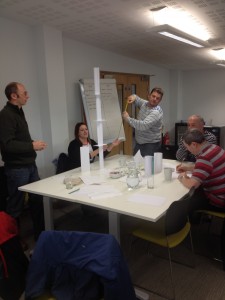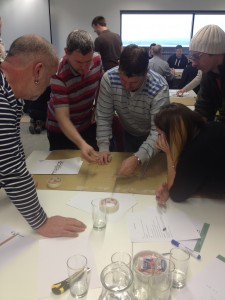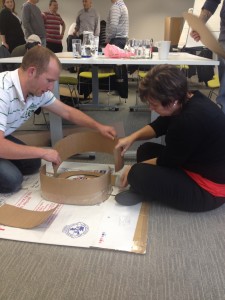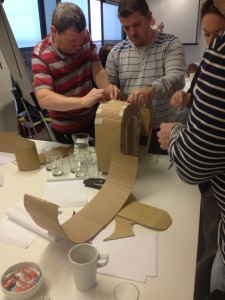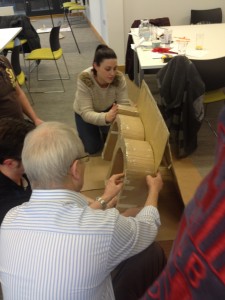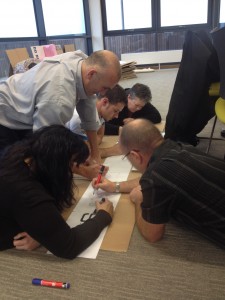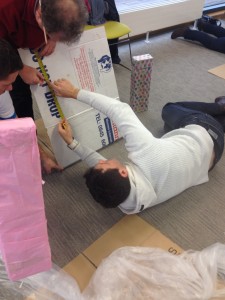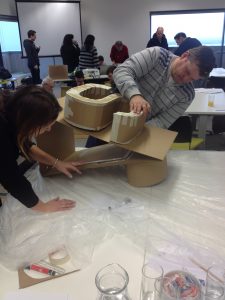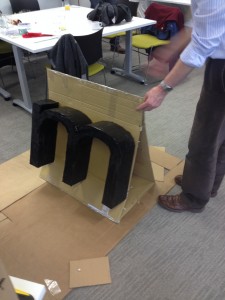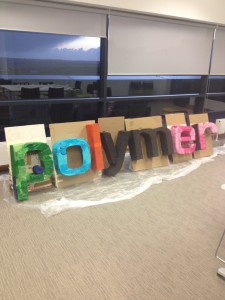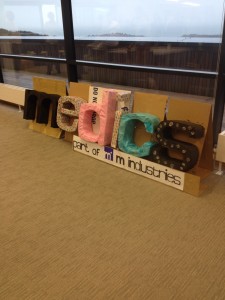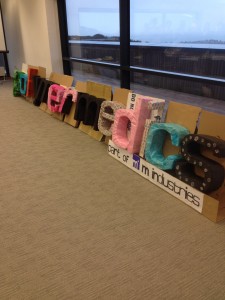By Carl Fitzsimons.
Carl is HR Director: UK, Ireland & Netherlands at John West Foods.

Carl sent me this piece he wrote recently and I wanted to share it with you – he kindly gave me permission to do so.
What colour is your black belt?
A strange question? Perhaps.
For some five years now I have been taking my children week in week out to learn Shotokan Karate. They have learned well, as all children do of course, given the right environment.
As an encouraging [my kids might even venture ‘pushy’] father on the sidelines, I spent the first few years sitting watching, offering unwanted advice [clearly an expert critic from the chair] and I enjoyed how expertly our 7th Dan Sensei Keith Callaghan, and his team built their confidence and discipline in this martial art.
From my comfy seat I watched my children learn the basic sequence drills (Kata), take part in safe sparring (Kumite) and then perform well at various team and individual competitions… and in turn develop their skills to move through the various coloured belts on their hopeful quest for their own black belt, one day.
As I was sat watching my children for 2-3 hours each week taking part in a highly engaging and challenging activity which was doing wonders for their fitness, my time on the sidelines allowed me the opportunity to make 3 interesting observations, endure 3 uncomfortable thoughts, find 2 key Learning Points and ultimately enjoy 1 moment of inspiration :
Observation #1 :
I was actually spending the same amount of time each week as my children at the Karate Dojo (Classroom) but whilst they were getting fitter, taking part and enjoying learning a new sport, I was becoming an armchair critic. Why wasn’t I joining in too?
I knew the answer:
Uncomfortable thought #1: I was fearful. Not, as you might think fearful of the potential of physical harm in a martial art – the club is very well run, with good ‘spirit’ and clear guidelines on personal safety etc. – the fear of the physical side really didn’t enter my head. No, my fear was more profound than that, I was fearful that I just wouldn’t be very good.
Uncomfortable thought #2 :- If I joined in I would be the most junior student here, at 40 years of age – I would be outranked by 5 year olds…I would be stood with the youngest children at the end of the line (in the Dojo the belts stand in rank). I may even have to be taught by my children at some point. Wow, this really didn’t appeal.
Uncomfortable thought #3
If I failed – I would have to return red faced to the sides again to take up my position as “watcher”, how would I look to the other parents, the club officials, most importantly my family…the guy who just couldn’t hack it …How could I or anyone face this ?
My Ego was shouting very loudly “THIS IS A REALLY BAD IDEA CARL, LET IT GO. BE VERY CAREFUL HERE – YOU COULD BREAK US”
These thoughts sat with me for a while, weeks in fact and they burrowed away. Here I was a reasonably successful person with a lovely family, worried about failing at something that no-one in the world actually expected of me. The only person judging me here was me…annoyingly for me I was a tough judge.
My Learning Point #1 :
“The fear of failure is not simply an immobilizer – it doesn’t just stop you – it actively holds you down.”
So, here I was annoyed at myself for failing at not starting something. How bizarre.
As a relatively tolerant person – someone who often has to defuse tensions between others (I work in HR after all!) I realized I had to do something – even if the rising tensions suggested the fight coming was only with myself. I really didn’t like this feeling of letting myself down. I had to do something.
So I devised a simple plan – I would be able to talk myself either into or out of the decision – by finding out more about the topic. An interesting tactic here – If in doubt – delay – use the opportunity to find out more…but nevertheless, the feeling of unease lessened, I was doing something.
I started reading around the topic of Karate, its history, its meaning, its techniques, its systems. It was a hugely fascinating read by the way, one I would recommend, but that’s for another time.
Observation #2 :
During this period of research – I also noticed something quite interesting at the time of the various classes and gradings my children were attending. The hugely positive effect that gaining and holding the next coloured belts had on the confidence levels of all of the students
I learned that the Coloured belts system in Karate is actually a relatively modern day invention dating from the early part of the last century, previous to this time, graduating martial arts students may have been presented with a certificate at best – they would not openly wear any insignia that showed their level of competence. It simply wasn’t done.
The Belt system, even today can vary between associations, my childrens Karate club used a system which progresses through 10 levels (or Kyu’s):
White, Orange, Red, Yellow, Green, Purple, Purple & White, Brown, Brown & White and then Black.
The Sensei’s decide at what point individuals progress through his/her ranks at formal Gradings
For the uninitiated – a Grading is quite a grand affair – it’s a time when all students young and old have to formally demonstrate their new skills to their sensei, each other and their family and friends – a chance to prove they have what it takes to wear the next and higher belt. It’s a pressurized experience yes, but a supportive environment – if you are entered to grade – you have the skills, your Sensei presents you for grading when he/she knows you have the ability – the challenge here simply is to show the world what you can do.
For my kids – I always looked forward to these events (they didn’t!) – as it was their opportunity do justice to the new skills they had acquired. If you fail to perform on the day, you don’t grade… a good life lesson here I thought for my children …you need to step up when it matters.
At the end of a grading the various students who achieved their standard are presented with a brand new coloured belt to signify to others their skills, the belt is so new and starched it can hardly be tied in a knot.
At each grading there are bags full of brand new belts presented to an array of smiling faces, belts of all colours including new black belts for those students attaining the first summit of achieving their Dan grade. Understandably these students usually wore the biggest smiles
Observation #3:
What struck me as really odd though – was this…despite the ready and available supply of new black belts at these Gradings – all the senior Sensei’s wore Black belts that were actually quite threadbare – the colour of black hardly recognizable, the dye worn and the once tough cotton, now soft and frayed. They looked scruffy almost.
Was this some odd cost saving measure? – were Black belts more frugal than most ?
Maybe it was a trust thing…you only get one belt – so don’t lose it, right?
If I was a Black belt – wouldn’t I want to look as smart as those newly appointed to my ranks?
Why were the senior Dan grades not proud enough to want to look their best in front of their students and the watching public?
These simple questions intrigued me.
The single answer to them all –proved to be hugely insightful, an epiphany almost – an insight into the philosophy underpinning Karate which changed my entire outlook on the sport – my personal fear of failure and in truth altered my approach to any future challenges I now take on.
Let me share what I learned.
There is a very clear reason for the condition of a Senior Sensei’s belt. It is based on traditional Japanese thinking and it goes to the very heart of learning, leadership and personal growth.
The answer is this :
The coloured belt system exists only to satisfy the ego of the Karate student. As the pupil gets stronger in the art, he/she has their ego rewarded by the ‘outward’ trophy of another coloured belt – one closer to the black belt they ultimately crave. The colored belt tells the world the student’s level of proficiency, their skill, at best it’s a reference point for further improvement , at worst it can even serve boastful tendencies
However – when the black belt is finally achieved – the individual transitions quickly from pupil to teacher. This is an important change.
As a Sensei they are deemed to have acquired sufficient knowledge that they are now trusted to teach others. From this moment on – the Sensei’s purpose should be devoting their time and attention to build the capability of others.
And so, over time, as the Sensei ties and reties their belt to teach, the colour and texture of their shiny black belt begins to fade and wear…until eventually, over many hours and years of teaching their black belt loses its colour and slowly returns to the colour white.
For the Sensei this is a good thing as a threadbare white belt serves as a symbol, a constant reminder, that he/she was only ever a white belt all along.
An honourable and experienced Sensei needs no further trophy to acknowledge their progress. Ego no longer is a driving force for the individual; they have no truck with it. Energy must now be invested in others.
Becoming a successful Black belt is actually an object lesson in humility.
My Learning Point #2
How often do we as Leaders in our various worlds, stop to reflect that as we get closer to the pinnacle of our profession, our industry, that our single greatest challenge is actually to adopt humility? Our focus should move from achieving our own ambition to helping others achieve theirs.
The humbleness required for a leader to become a “capability builder” in others, before they have reached their own personal career goal – is quite a remarkable challenge. But the rewards, for all here, are immense.
In fact, in Karate, humbleness does still lead to recognition, its just that it’s seen as a by-product rather than a fixated goal or promise. The highest Dan Grade in the sport ( 7th to 10th Dan) are actually honourary leadership grades achieved not through an individual’s self-promotion or technical capability but rather through the ambition others hold for them. The energy of the senior ranks the Sensei has humbly trained around them becomes quite considerable and it is this group that then publically pushes to formally recognize and acknowledge the individuals service to the highest accolade in the sport.
So how do you make a start on becoming a humble great leader?. I humbly offer that maybe the first step to becoming a great leader is to recognize that we never have the right to think of ourselves as one.
If you are a leader worthy of note, others will decide this for you, in time. In short, our ego has no role to play in this debate.
Challenge yourself to remove your reliance on your ego. Sure, it has comforted & supported you so far, but the final steps on the journey must be made alone. Remove this reliance and anything is possible.
My Epilogue (and inspiration):
So here I sat…watching my family in the Karate class with the personal insight that the very thing that was holding me back, my ego, was the very thing this martial art sort to remove.
“THIS IS A REALLY BAD IDEA CARL, LET IT GO. BE VERY CAREFUL HERE – YOU COULD BREAK US”
We needed to be broken.
Next class I lined up, at the far left end of the line, with a 5 year old red belt to my right, who slowly looked me up and down from head to toe and then told me “you look funny, and you’re too big and old to be stood here”.
My ego’s first test. I bit my lip, smiled and suppressed the urge to walk. I persevered.
2 years on…my Children have both achieved their shiny Black Belts and are comfortably making the transition into teachers. My teachers. There is plenty of time for their colour to fade.
Me? I am immensely proud of their journey and I am enjoying my own. I have stuck it out, I was poor at the start and then I got better, slowly, week by week. Not great, but better. I get better each class.
I now stand in the middle of the lineup, proudly at 4th Kyu (Purple & White belt)…I enjoy the training, I even enjoy looking foolish occasionally as I turn one way, at the wrong time, only to find the rest of the class all facing me and smiling at my error.
I have even managed to win a shiny medal or two at the odd tournament (ego still being nourished a little we note!)…but more importantly I am just enjoying the ride, learning to learn again. I have learned to be taught with and by many different people, often with my own children being my toughest and most critical of teachers.
At work – well, I now actively try to promote and push others in my team, my peers and business to develop, to trust their inner voice to take a risk and do something new. Their progress can be startling at times, even humbling.
As a senior leader in my business my “Black belt” is still quite new, but hopefully the fading process is starting.
Carl Fitzsimons FCIPD
HR Director of John West,
